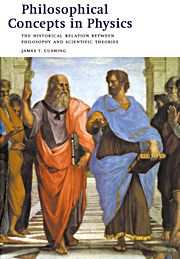 Philosophical Concepts in Physics
Philosophical Concepts in Physics Book contents
- Frontmatter
- Contents
- Preface
- Copyright acknowledgments
- PART I The scientific enterprise
- PART II Ancient and modern models of the universe
- PART III The Newtonian universe
- PART IV A perspective
- PART V Mechanical versus electrodynamical world views
- PART VI The theory of relativity
- 16 The background to and essentials of special relativity
- 17 Further logical consequences of Einstein's postulates
- 18 General relativity and the expanding universe
- PART VII The quantum world and the completeness of quantum mechanics
- PART VIII Some philosophical lessons from quantum mechanics
- PART IX A retrospective
- Notes
- General references
- Bibliography
- Author index
- Subject index
17 - Further logical consequences of Einstein's postulates
Published online by Cambridge University Press: 05 June 2012
- Frontmatter
- Contents
- Preface
- Copyright acknowledgments
- PART I The scientific enterprise
- PART II Ancient and modern models of the universe
- PART III The Newtonian universe
- PART IV A perspective
- PART V Mechanical versus electrodynamical world views
- PART VI The theory of relativity
- 16 The background to and essentials of special relativity
- 17 Further logical consequences of Einstein's postulates
- 18 General relativity and the expanding universe
- PART VII The quantum world and the completeness of quantum mechanics
- PART VIII Some philosophical lessons from quantum mechanics
- PART IX A retrospective
- Notes
- General references
- Bibliography
- Author index
- Subject index
Summary
In this chapter we consider several of the empirical implications that follow from Einstein's two postulates and relate these to experimental tests of special relativity. The emphasis is on how many diverse, quantitative predictions result from two verbal statements that appear so disarmingly simple and qualitative in nature. Just as Newton's system of classical mechanics and theory of gravity gained universal acceptance because of its many quantitative successes and its wide range of applicability to seemingly unrelated phenomena (recall Chapter 11), so Einstein's special theory of relativity soon became the dominant theory because of the great scope of its achievements.
RELATIVISTIC DOPPLER EFFECT
We begin by considering the effect that relative motion has on the measured frequency of light. In a classical, or nonrelativistic, context this was originally discussed by Christian Doppler (1803–1853) in 1842. The relativistic version was first treated by Einstein in his 1905 ‘relativity’ paper. In Figure 17.1 let observer B be moving parallel to and in the same direction as the propagation of the wave front, all as seen by observer A. From the point of view of A, for whom the wavelength (or distance between successive wave fronts) is λ, the time t that it takes for two successive wave fronts to pass the moving observer B is t = (λ + vt)/c. Denote by t′ (a proper time) the time B measures between the passage of these two wave fronts (past B).
Information
- Type
- Chapter
- Information
- Philosophical Concepts in PhysicsThe Historical Relation between Philosophy and Scientific Theories, pp. 241 - 251Publisher: Cambridge University PressPrint publication year: 1998